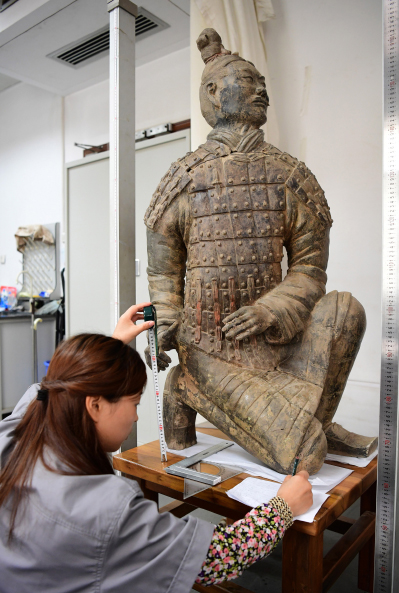| China |
| The first emperor's guards stand the test of time | |
|
|
 A researcher measures a terracotta warrior statue in Xi'an, Shaanxi Province, on September 1, 2017 (XINHUA)
In March 1974, Yang Zhifa, his five brothers, and their neighbor Wang Puzhi set out to dig a well near the Lishan Mountain in Lintong, east of Xi'an. Lintong was an area full of underwater springs and water courses, so they knew that they wouldn't have to dig far before finding water. What they discovered instead that day led to one of the greatest archaeological discoveries in Chinese history—the Terracotta Army of Emperor Qinshihuang (259-210 B.C.) of the Qin Dynasty (221 -206 B.C.). Since their discovery and subsequent uncovering, the Terracotta Army has become the most famous tourist site in Shaanxi Province, and the image of the terracotta warriors has become synonymous with the capital city of Xi'an itself. The vast collection of more than 8,000 statues is just part of a larger funerary necropolis built for the First Emperor of China, Qinshihuang. While much of the site remains covered in order to preserve the artifacts within, the terracotta warriors have been painstakingly uncovered in four pits over the past several decades. The terracotta warriors are impressive in that each statue is unique, with different features, clothing, and poses, a testament to the craftsmanship of the sculptures and a symbol of the lands conquered by the first emperor. Though the statues are famous for their pale grey appearance, they were originally brightly colored, and had a variety of weapons that they would use to protect the emperor in the afterlife, facing east toward the conquered lands of his enemies. In addition to the damage sustained early on, the ravages of time have also taken their toll. Some statues were damaged when tombs or other constructions were built over the two millennia. Though many of the statues were quite well-preserved, once uncovered and exposed to oxygen, the paint on some began to flake and fall off mere minutes after being uncovered, presenting a challenge to researchers and causing them to move more carefully while uncovering the site. Still some of the statues retain bits of their original paint, and techniques being developed may allow for a fully painted warrior to be uncovered and preserved for people to see. When I first saw the terracotta warriors in 2006, the scale of the endeavor became apparent. It is one thing to see photos, or even video, of the site; it is another to see them in person. Though at that time excavations were still under way, standing in the massive hall that was reminiscent of the warehouse from the end of Indiana Jones, it was easy to see the massive amount of labor that had gone into this imperial memorial. At the time, it was difficult to see the details of each statue, as the viewing area was quite far from the pit itself, though luckily there were several statues encased in glass boxes that allowed us to see the finer details. Further trips to the Shaanxi History Museum allowed us to better examine some of the relics, in addition to other pieces that had been uncovered, such as the chariots and horses of Pit 2. Being able to look into the eyes of these ancient statues was like looking directly into the past, at people long gone from the world. The impact of these statues has gone global as well, with the Terracotta Warrior Overseas Exhibition, which ran from 2010 to 2020. You can also see the terracotta warriors popping up increasingly in various types of media, from The Mummy: Tomb of the Dragon Emperor to appearing in the background of various rare collections across multiple television shows. The Terracotta Army remains an important relic to both China and the world and due to the preservation and care of the archaeologists, it will be enjoyed by people for generations to come. The author, an American living in Xi'an, Shaanxi Province, is editor in chief of XIANEASE magazine (Print Edition Title: Terracotta Warriors: Preservation and Impact) Copyedited by Ryan Perkins Comments to linan@bjreview.com |
|
||||||||||||||||||||||||||||||
|
